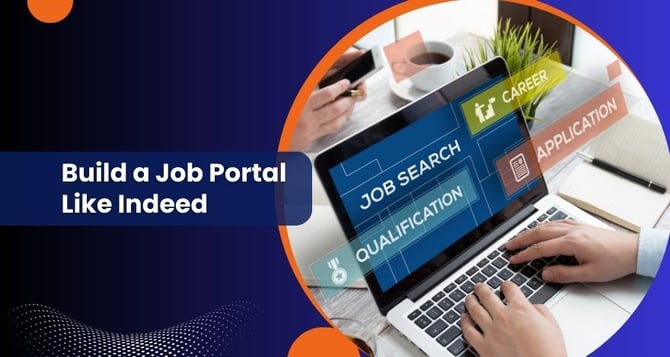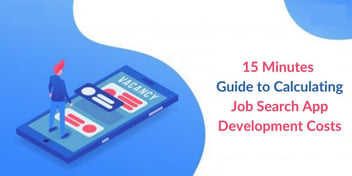How Much Does it Cost to Build a Job Portal Like Indeed?
Building a job portal website like Indeed involves comprehensive planning and costs. Learn about the essential factors influencing expenses, from development to design, features, and infrastructure. Gain a comprehensive understanding of how to build job sites like Indeed.

Job portals have become an essential tool for both job seekers and employers. These platforms serve as a bridge between talent and opportunities, making the job search process more efficient and effective. This is also why the global online recruitment market was worth $2.91 billion in 2021. Moreover, it is estimated to reach $3.64 billion by 2026.
Given the potential for such exponential growth in the online recruitment field. This makes it the right time to tap into its income by establishing your job platform. This must make you want to know more about lucrative job websites like Indeed. Therefore, read the article below. It will discuss the intricacies of building a job portal website similar to Indeed.
Job Portal: Definition and Features
A job portal is a website where job seekers and employers connect. It's like a digital marketplace for jobs. Job seekers can search for jobs, create profiles, and apply online.
Job portal development involves creating a dynamic online platform that connects job seekers with employment opportunities.
Employers post job listings, review applications, and find suitable candidates. Job portals make the job search and hiring process easier and more efficient. Some of the features of a job portal website are:
1. Job Listings
Employers post detailed job openings on the portal, providing information about the position and necessary qualifications. This allows job seekers to explore a wide range of opportunities available in various industries.
2. Search Filters
Search filters are employed to assist job seekers in efficiently finding the right job. These filters enable users to refine their job search based on location preferences, type of job, and experience level. This saves time by presenting them with options tailored to their preferences.
3. Resume/CV Upload
Job seekers can easily upload their resumes or CVs to their profiles on the portal. This enables them to showcase their educational background, work experience, skills, and accomplishments all in one place. To create a professional and well-structured resume, candidates can use a resume builder, making sure their resume highlights key qualifications effectively. Employers can then easily review these documents to evaluate the suitability of candidates for their job openings.
4. Application Submissions
The portal facilitates a streamlined application process. Job seekers can submit their applications directly through the platform. They can even attach the resume they uploaded earlier and compose cover letters online. This simplifies the application process, making it more accessible and efficient.
5. Profile Creation
Job seekers can create comprehensive profiles that serve as digital resumes. These profiles go beyond the traditional paper-based CVs, allowing candidates to showcase their skills and noteworthy achievements. Employers can peruse these profiles better to understand candidates' capabilities and suitability for their organizations.
6. Notifications
The portal ensures users remain actively engaged throughout the job search and application process. Therefore, notifications are sent to users to achieve this. These notifications encompass various aspects, including new job updates, application status, and messages from potential employers. This keeps users informed and encourages timely responses.
Determining the Scope of a Job Portal Development
Before creating a job portal website, it is crucial to decide its scope. Here are some of the essential aspects to consider:
1. Target Audience and Geographic Coverage
The success of a job portal hinges on understanding its intended users. It must ascertain whether it targets fresh graduates, seasoned professionals, or specific industries. This segmentation ensures that the portal's resources cater precisely to the needs of its audience.
Furthermore, the geographic scope of the portal shapes the diversity of opportunities available. The local presence of the portal may benefit those seeking nearby positions, whereas a global presence widens horizons, catering to a larger pool of candidates. Thus, the portal must offer a tailored and effective job search experience by aligning its focus with user demographics and preferred locations.
2. Types of Jobs and Industries
The specialization of a job portal in terms of the types of jobs and industries significantly shapes its purpose and impact. A broad approach could offer diverse job categories, serving a wide audience seeking various roles.
Conversely, focusing on specific sectors such as technology or finance makes the portal for specific professions, aiding professionals and employers in those fields. This deliberate choice defines the portal's unique value proposition, guiding job seekers to opportunities aligned with their expertise. These strategic decisions profoundly influence the portal's relevance and effectiveness within the job placement market.
3. Additional Features
A job portal's utility goes beyond job postings. It must have supplementary tools like resume builders and an applicant tracking system. These features will empower job seekers to formulate compelling applications and help employers in application management respectively. Such value-added features transform the portal into a comprehensive platform, enabling a seamless job search and recruitment experience. You should also read about the benefits of using the Applicant tracking system before subscribing to these services.
A portal becomes indispensable in talent acquisition by offering tools that enhance job seeker presentation and employer efficiency. This provides a comprehensive solution that benefits all stakeholders involved.
Cost Components of Building a Job Site Like Indeed
Determining the dynamics of your job is not everything that must be accounted for. Creating a job portal also involves various costs that need to be considered. Some of them are:
1. Website Development
Website development is the intricate process of designing, coding, and crafting a user-friendly interface for the job portal. This involves creating the visual layout, structuring content, and enabling seamless navigation.
Thus, the cost of website development depends on the complexity and intricacy of these parameters. Depending on these elements, the cost can range from approximately $30,000 to $200,000.
2. Backend Development
Backend development forms the core of any portal. It involved the establishment of a database and the functionalities that ensure a job portal's seamless operation.
Backend development comprises setting up the server, implementing data storage solutions, and creating the logic that drives user interactions. The cost of backend development varies based on the intricacy and integration of such databases. This cost usually ranges between $4,000 to $12,500 (Approx.).
3. Domain and Hosting
Domain and hosting are vital components of a website's online presence. The domain name serves as the web address. At the same time, hosting involves renting server space to store website files and making them accessible online.
Domain costs typically range from $6 to $15 annually, depending on domain extensions. However, hosting expenses depend on server capacity, features, and resources. Shared hosting may be cheaper at around $10 per month, while more robust options like VPS or efficient dedicated hosting can range from $20 to $200 monthly.
4. Security Measures
Security measures are crucial to protect user data and gain trust in the platform. This involves implementing strategies like encryption, intrusion detection systems, and firewalls to guard against cyber threats.
The cost of security measures depends on factors like data sensitivity, compliance standards, and implementation of secure authentication mechanisms. Generally, security expenses span from approximately $700 to $2,500.
5. Payment Gateway Integration
Payment gateway integration is crucial for enabling transactions within the platform, especially for charging employers for job postings. It involves connecting the portal to a secure payment processing system that handles financial transactions.
The costs associated with payment gateway integration vary depending on factors such as the payment gateway provider, the complexity of integration, and the desired features (like subscription management). Such integrations are usually charged as 2.9% + $0.30 per transaction.
Related Read: 5 Must-Ask Questions While Building a Job Portal
Additional Costs to Consider When Building a Job Portal
Apart from the core job portal development cost, several other expenses arise when building a platform. It includes the following:
1. Marketing and Promotion Expenses
Once the platform is ready, spreading the word requires investment in marketing and promotion. This covers online advertising, social media campaigns, and possibly partnerships. Although it can vary widely, it typically ranges from $2,500 to $12,000, depending on the promotion scale.
2. Ongoing Maintenance and Updates
After launch, maintaining the platform and implementing updates is a recurring expense. This can cost around $5 to $5,000 per month, depending on the platform's size and requirements.
3. Scaling and Infrastructure
As the platform gains users, scaling up the infrastructure becomes necessary. This could involve increased server capacity, database management, and software upgrades. Scaling costs can grow with the platform's success, which is why there are no exact figures for the same.
Factors Influencing the Cost
The cost of building a platform can vary significantly due to several factors. Thus, understanding these influences is crucial for budgeting accurately:
1. Customization Level
Customization in job portal website development involves tailoring the platform to unique requirements beyond standard features. This requires additional coding, testing, and design efforts.
The expenses naturally increase when a job portal aims for a high degree of customization, such as industry-specific functionalities or unique user experiences.
2. Technology Stack
Selecting the technology components for a job portal significantly influences costs. Certain technologies demand specialized skills and expertise, which can lead to higher development expenses.
Moreover, the choice of programming languages, frameworks, and third-party integrations affects initial development and ongoing maintenance and updates. Thus, newer or specialized technologies can escalate costs due to limited expertise and potentially longer development times.
3. Development Team Expertise
The expertise of the development team significantly influences job portal costs. Although skilled teams charge high rates, they bring valuable efficiency and expertise. Their experience streamlines the development process, potentially offsetting higher upfront costs with quicker, high-quality results.
Thus, sometimes collaborating with a global development personnes can also be necessary to get cutting-edge solutions. However, this might involve hiked and varied cost structures based on geographical location.
4. Design Complexity
Creating elaborate and visually appealing designs for job portals involves a comprehensive design process. This requires the expertise of graphic designers and UI/UX experts who ensure a captivating and user-centric interface. Intricate designs with interactive elements, responsive layouts, and personalized user experiences demand more design work, coding, and testing. Consequently, the development time extends, and all these factors cumulatively increase costs.
How to Build a Job Portal Like Indeed?
Creating job portal websites like Indeed involves the following steps:
1. Planning and Research
Begin by analyzing various job portals. Understand your target audience and the industry segments you intend to cater to. Based on these insights, carve out a unique value proposition and set clear goals for your platform's direction.
2. Technical Specifications
Choose a suitable technology stack that aligns with your requirements. You must prioritize factors like scalability, security, and performance to ensure a solid foundation for your portal.
3. Design and User Experience
A user-friendly design guarantees effortless navigation and seamless interaction. Thus, you must pay particular attention to responsive design to accommodate users on various devices.
4. Frontend Development
The Frontend interface is where users engage directly with your portal. Thus, you must employ cutting-edge programming languages like HTML, CSS, and JavaScript to bring your platform to life.
5. Backend Development
The backend fuels the platform's functionalities. This includes everything from user authentication to job listing management and search algorithms. Therefore, you must use languages like Python, Ruby, or Node.js to build a strong core of your platform.
6. Database Setup
You must implement a robust database system like MySQL or PostgreSQL. This serves as the repository for user profiles and job listings, ensuring smooth data management.
7. Testing and Quality Assurance
Before opening your platform to the world, you must rigorously test it. This will help you identify and rectify bugs to guarantee a seamless user journey and maintain the platform's credibility.
8. Deployment and Hosting
Lastly, deploy your platform onto a web server, ensuring it's accessible to users. Also, opt for hosting solutions that align with your projected scalability needs.
Let Us Help You Bring Your Idea to Life
Building a job site like Indeed requires careful planning, a comprehensive understanding of the market, and a well-structured budget. You can create a platform that effectively connects job seekers and employers by considering the above factors. It will help you build your job portal more effectively and efficiently.
If you require help building a job portal, consult Signity Solutions. We have been catering to website development-related requirements for more than 13+ years.
Moreover, Signity Solutions is proficient in building digital commerce platforms and has retained more than 80% of its clients.
Frequently Asked Questions
Have a question in mind? We are here to answer.
How Long Does it Take to Develop a Job Portal?
![]()
The development timeframe of the portal can vary depending on the platform's complexity, features, and team size. It may take anywhere from 4 to 12 months or more.
Is it Necessary to Have Mobile Apps for the Job Portal?
![]()
How can you Monetize your job Portal?
![]()
What are Some Effective Marketing Strategies for a job Portal?
![]()


.png?width=1200&height=250&name=Robotic%20Process%20Automation%20in%20Customer%20Satisfaction%20-%20CTA%20(4).png)













